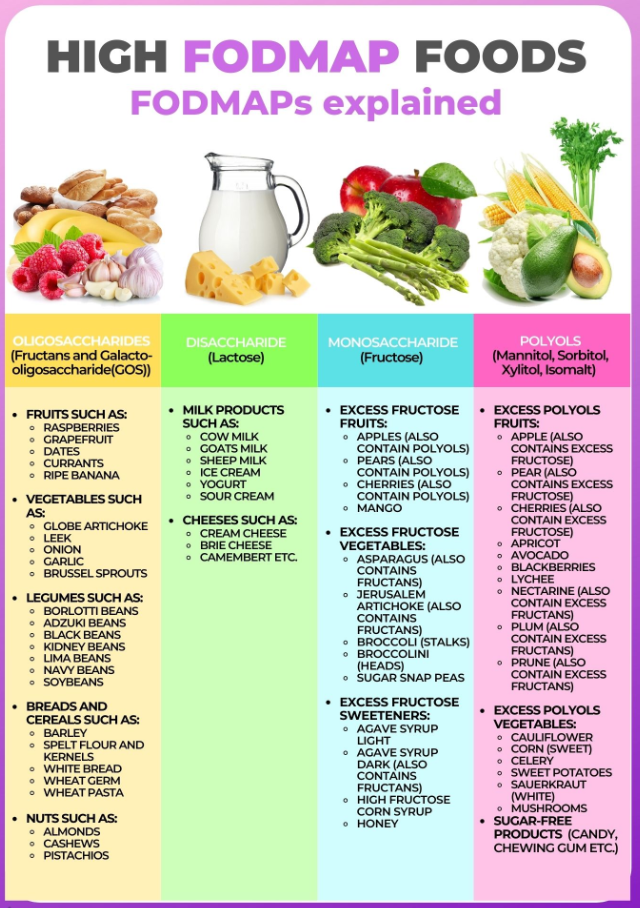BOURSESSENEGAL – Navigating dietary restrictions can be challenging, especially when it comes to managing digestive health. If you’re wondering about high FODMAP foods, you’re not alone. Many people experience digestive issues and find that a low FODMAP diet helps alleviate symptoms. In this guide, we’ll explore what FODMAPs are, identify high FODMAP foods, and discuss how to manage your diet effectively.
What Are FODMAPs?
FODMAP stands for Fermentable Oligosaccharides, Disaccharides, Monosaccharides, and Polyols. These are short-chain carbohydrates that the small intestine absorbs poorly. When these substances reach the large intestine, they can cause various digestive issues, including bloating, gas, and abdominal pain.
Breakdown of FODMAP Components
- Oligosaccharides: Found in foods like wheat, rye, onions, and garlic.
- Disaccharides: Lactose is the primary component in dairy products.
- Monosaccharides: Fructose, commonly found in honey, high-fructose corn syrup, and certain fruits.
- Polyols: Sugar alcohols found in some fruits and artificial sweeteners.
Understanding these components is crucial for identifying high FODMAP foods that may trigger your symptoms.
Common High FODMAP Foods to Avoid
If you’re considering a low FODMAP diet, you’ll need to avoid certain foods. Here’s a detailed list of high FODMAP foods organized by category.
1. Grains and Cereals
Certain grains can be high in FODMAPs:
- Wheat Products: Bread, pasta, cereals, and baked goods made with wheat contain oligosaccharides.
- Rye Products: Rye bread and crackers can also contribute to FODMAP intake.
2. Dairy Products
Many dairy products contain lactose, making them high FODMAP:
- Milk: Cow’s milk, goat’s milk, and sheep’s milk.
- Soft Cheeses: Such as ricotta and cream cheese.
- Ice Cream: Many ice creams contain lactose.
3. Vegetables
Several vegetables are high in FODMAPs:
- Onions and Garlic: Common flavor enhancers in many dishes.
- Cauliflower and Mushrooms: Both can cause digestive distress in sensitive individuals.
- Asparagus and Artichokes: These are also known for their high FODMAP content.
4. Fruits
Some fruits contain high levels of fructose or polyols:
- Apples and Pears: These fruits have a high fructose content.
- Watermelon: Known for its polyol content.
- Cherries: These can also be problematic for many.
5. Sweeteners
Certain sweeteners can trigger symptoms:
- Honey: High in fructose.
- High-Fructose Corn Syrup: Commonly found in processed foods.
- Sugar Alcohols: Such as sorbitol and mannitol, found in sugar-free products.
Symptoms Associated with High FODMAP Foods
Consuming high FODMAP foods can lead to various digestive symptoms, including:
- Bloating: A feeling of fullness or swelling in the abdomen.
- Gas: Increased flatulence and burping.
- Abdominal Pain: Cramping or discomfort after meals.
- Diarrhea or Constipation: Changes in bowel habits can occur.
Recognizing these symptoms helps you understand how high FODMAP foods may affect your body.
Managing a Low FODMAP Diet
Transitioning to a low FODMAP diet can seem daunting, but with some planning, it becomes manageable.
1. Elimination Phase
Start by eliminating all high FODMAP foods from your diet for 4-6 weeks. This phase helps identify whether these foods trigger your symptoms. Keep a food diary to track what you eat and how you feel.
2. Reintroduction Phase
After the elimination phase, gradually reintroduce high FODMAP foods one at a time. This helps pinpoint specific triggers. Monitor your symptoms closely and note any adverse reactions.
3. Personalization Phase
Once you identify your trigger foods, create a personalized diet plan. You don’t need to eliminate all high FODMAP foods—many individuals can tolerate small amounts without experiencing symptoms.
Tips for Eating Out and Shopping
Dining out or grocery shopping can be challenging on a low FODMAP diet. Here are some practical tips:
1. Eating Out
- Choose Restaurants Carefully: Opt for places that offer customizable options.
- Ask Questions: Inquire about ingredient preparation and cooking methods.
- Plan Ahead: Review menus in advance to identify suitable dishes.
2. Grocery Shopping
- Read Labels: Always check ingredient lists for hidden FODMAPs.
- Stick to Whole Foods: Fresh fruits, vegetables, and meats are often low in FODMAPs.
- Use Apps: Several apps can help you identify FODMAP-friendly foods and recipes.
Recipes to Try: Low FODMAP Options
Here are a couple of delicious low FODMAP recipes to get you started:
1. Quinoa Salad
Ingredients:
- 1 cup cooked quinoa
- 1 cup diced cucumber
- 1/2 cup diced bell pepper
- 1/4 cup chopped parsley
- 2 tablespoons lemon juice
- 1 tablespoon olive oil
Instructions:
- In a large bowl, combine all ingredients.
- Toss gently to mix.
- Serve chilled or at room temperature.
2. Grilled Chicken with Herbs
Ingredients:
- 2 chicken breasts
- 2 tablespoons olive oil
- 1 teaspoon dried thyme
- Salt and pepper to taste
Instructions:
- Preheat the grill.
- Rub chicken breasts with olive oil, thyme, salt, and pepper.
- Grill for 6-7 minutes per side or until cooked through.
- Serve with a side of low FODMAP vegetables.
Conclusion: Finding Balance with High FODMAP Foods
Understanding high FODMAP foods empowers you to make informed dietary choices. By recognizing your triggers and following a structured low FODMAP diet, you can significantly improve your digestive health. Remember, this journey requires patience and personalization. With time, you’ll find the right balance that works for you.
If you have persistent digestive issues, consider consulting a healthcare professional or a registered dietitian. They can provide tailored guidance and support as you navigate this dietary approach. Embrace the journey toward better digestive health with confidence and knowledge!
REFERENCE : https://www.health.com/



